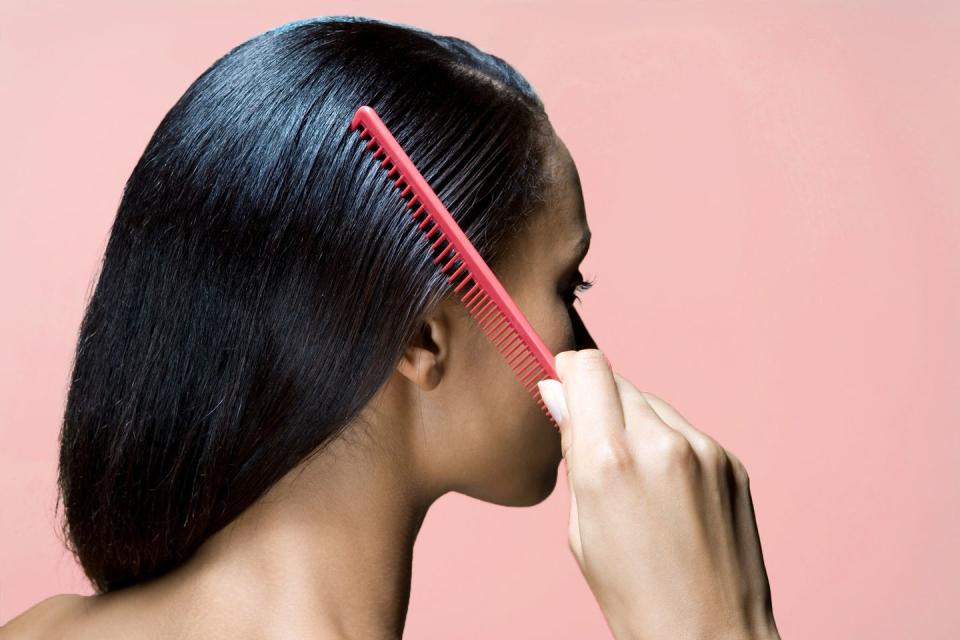If You're Dealing With Hair Loss, Know That You're Not Alone

If you’ve noticed patchy or thinning spots on your scalp or a surplus of hair strands on your hairbrush or in the shower, you're not alone. More than half of all women will experience noticeable hair loss, according to the Cleveland Clinic. In order to put a stop to shedding, though, you have to figure out the root of the problem. “Hair loss is not a diagnosis,” says Yolanda Lenzy, M.D., M.P.H.,board-certified dermatologist and licensed cosmetologist in Chicopee, Massachusetts. “Hair loss is a symptom. Once you get a specific diagnosis, then you can know the causes associated with that diagnosis.”
For starters, know that the term “alopecia” refers to all kinds of hair loss. There are two main types of alopecia, and then a variety of forms of hair loss within those two categories. In cases of non-scarring or temporary hair loss, the missing hair will eventually grow back. With scarring or permanent hair loss, permanent damage is done to the hair follicles so they won’t grow back. “With scarring hair loss, the goal is not for it to grow back, but to stop the progression,” says Dr. Lenzy. Below, are seven different kinds of alopecia —knowing which one you’re suffering from will help determine the proper treatment.

Non-scarring (Reversible) Forms of Hair Loss
Androgenetic alopecia
When people talk about male or female pattern hair loss — typically a receding hair line in men or thinning at the crown in women — that’s androgenetic alopecia. It’s the most common form of hair loss among all people. In fact, research shows that more than 50% of women will develop androgenetic alopecia by the age of 80. “It can come from either side of the family in men or women, skip a generation, and start earlier in the next generation that the one before it,” says dermatologist Carolyn Goh, M.D., Health Sciences Assistant Clinical Professor at the David Geffen School of Medicine and Director of the Hair and Scalp Disorder Clinic at UCLA. “However, some people have pattern hair loss without a family history of it.” While some women start showing signs of androgenetic alopecia in their teenage years, others won’t experience it until their 50s or 60s. “When nearing menopause, the decrease of estrogen means you have unopposed testosterone,” says Dr. Lenzy. “That elevated testosterone can convert to a hormone called dihydrotestosterone (DHT), which contributes to the thinning of the hair follicles — the follicles actually get smaller in this particular form of hair loss.”
Telogen effluvium
Telogen effluvium is just a fancy name for excessive hair shedding — an annoyance that many people will experience at some point in their life. “A common cause is stress, usually meaning major life stressors or physical stressors like surgery, medication (including over the counter ones and supplements), weight loss, or a death in the family, to name a few,” says Dr. Goh. “It usually starts three to six months after a stressor and then lasts for three to six months.” Hypothyroidism and iron deficiency can also trigger telogen effluvium. “The beautiful thing about it is 70% of your hair strands are still in the anagen or growing phase,” adds Dr. Lenzy. “Because the hair follicles work in a cycle, you won’t go bald.”
Alopecia areata
This type of hair loss affects about 2% of people and usually appears as round smooth circles anywhere on the head without any redness, itching, or pain. “Alopecia areata is thought to be caused by an autoimmune process,” says Dr. Lenzy. “The body’s immune system makes some mistakes and produces T cells that attack hair follicles.”
Traction alopecia
Thinning and bald patches at the temples or where hair is frequently pulled tight can indicate traction alopecia. “This very common form of hair loss is caused by haircare and hairstyle practices — practices which place excessive tension or weight on the follicles like braids, ponytails, hair extensions, or locs.”
Scarring (Permanent) Forms of Hair Loss
Central centrifugal cicatricial alopecia (CCCA)
“Central centrifugal cicatricial alopecia tends to start on the top of the head with breakage and thinning, and often with some tenderness of the scalp,” says Dr. Goh. “It gradually spreads outward and can cause permanent hair loss.” CCCA is especially common among Black women. “Some recent studies have found that about 25% of people with this form of hair loss have a genetic mutation in one of the proteins that’s responsible for the formation of the hair follicle,” says Dr. Lenzy. On top of that, she notes that the same haircare practices that create tension and cause traction alopecia also contribute to CCCA.
Lichen planopilaris (LPP)
Lichen planopilaris can result in patchy spots of hair loss as well as redness, itching, burning, or pain in the scalp. It’s a form of alopecia that’s found more commonly among caucasian women. LPP is thought to be autoimmune-related and but research is still being done to figure out the exact cause. “There’s some research that shows individuals with this form of hair loss have decreased activity of a very essential enzyme called PPAR-gamma,” says Dr. Lenzy. “PPAR-gamma is responsible for how our scalps metabolize lipids on the scalp so when individuals don’t have that active, they can develop LPP.” One particular form of LPP called frontal fibrosing alopecia (FFA) is becoming increasingly common in postmenopausal women, according to Dr. Goh. “In FFA, the hairline recedes gradually from the front and sides and sometimes the back of the scalp,” she says. “Eyebrows are often lost and sometimes eyelashes and other body hair.”
Lupus
“Lupus of the scalp is another form of scarring alopecia that’s autoimmune,” says Dr. Lenzy. “It’s common, especially in women of color.” It shows up as red, scaly, thick lesions that don’t usually hurt or itch.

The Difference Between Hair Loss and Hair Breakage
Trichorrhexis nodosa is the official name for hair breakage. It takes place mid-shaft while hair loss occurs at the scalp. For instance, if you see little hairs on the floor of different lengths, that’s a sign of breakage, says Dr. Lenzy. “But with shedding, the hair is coming out from the root so you will see long strands the entire length of your hair.” Hair color, excessive heat during styling, and chemical straighteners can all dry out hair strands, making them more likely to break. If your haircare practices are the culprit, you’ll see breakage throughout your hair. However, isolated breakage in one spot can be a sign of alopecia areata or CCCA.
Effective Hair Loss Treatments
The cause of your particular form of hair loss will point you toward the right treatment. For stress-related telogen effluvium, time is usually the best solution as hair should grow back six to nine months after the excessive shedding occurs. However, if your telogen effluvium is caused by an underlying health issue such as a thyroid problem or low iron levels, your hair should grow back after you address the underlying problem.
“Topical minoxidil (Rogaine) is the only FDA-approved treatment for hair loss in women,” says Dr. Goh. It’s technically approved for androgenetic alopecia, but it’s used for many types of hair loss, and it’s available over the counter. “A common reason people don’t try minoxidil is because they have heard you have to keep using it forever,” says Dr. Goh. “While it is true that minoxidil only works while you use it, it is also true of all treatments for hair loss as long as the underlying hair loss is chronic. It can become a routine like brushing your teeth.” Finasteride (Propecia) is FDA-approved for male pattern androgenetic alopecia and is quite effective, especially when combined with minoxidil. “It’s often prescribed off-label for women, but can cause birth defects so it’s usually used in women after child-bearing age,” notes Dr. Goh. “Spironolactone is another medication often used for women with female pattern hair loss that can cause birth defects so women are advised to use proper contraception while taking it.”
“If you have one of the forms of scarring alopecia that is inflammatory, such as CCCA, we often use antibiotics to decrease inflammation around the hair follicle,” says Dr. Lenzy. Topical or injection cortisones can also be helpful in reducing inflammation in CCCA as well as in alopecia areata. “There are a lot of new treatments on the horizon that are currently being studied in clinical trials for extensive forms of alopecia areata,” adds Dr. Lenzy. “Some of the treatments that are coming down the pike, we currently use off-label even though they’re not yet approved. In general, many of the treatments for hair loss are experimental because there’s just not a lot of FDA-approved treatments. But those of us who specialize in hair loss, we have a lot of effective therapies that we use.”

Hair Loss Treatments to Avoid
“Be cautious about vitamins, supplements, and shampoos that claim to help hair loss,” advises Dr. Goh. “None of these have been studied thoroughly and they often cost a lot of money.” There’s also little regulation of these products by the FDA so there’s no guarantee that they are both safe and effective.
In particular, you should steer clear of supplements that contain large amounts of biotin as there is little proof that it is helpful in people who have normal biotin levels — which is most people. “About two years ago, the FDA issued a warning that mega doses of biotin can alter many of your lab results, including your thyroid function tasks and cardiac enzymes,” says Dr. Lenzy. “People think just because something is ‘natural’ or a vitamin then it can’t be harmful, but that couldn’t be farther from the truth.” If you happen to take a multivitamin that contains a smaller amount of biotin, stop taking it two to three days before having any bloodwork conducted to ensure that your results are accurate.
While other purported natural treatments like castor oil might be benign, Dr. Lenzy doesn’t recommend them because they may not be effective. “If you have a form of scarring alopecia, the most important thing is for you to get an early diagnosis,” she says. “This is permanent hair loss so if you spend six months to a year trying castor oil, you’re losing precious follicles that whole time that you won’t be able to get back.” She says the best thing you can do is get a proper diagnosis from a doctor: “These are actual medical conditions just like high blood pressure or diabetes. I see so many people suffering and trying different things and if they had only come in sooner, their result would be so much better.”

When to See a Doctor for Hair Loss
Everyone’s shedding pattern is a little different so there’s no standard amount of hair loss that warrants a call to your dermatologist. “Some people shed very little and some people shed a lot at baseline,” says Dr. Goh. “We say losing 100 to 200 hairs per day can be normal and people usually shed more on a shampoo day than a non-shampoo day.” She points out that many people stop washing their hair when they see it falling out, but you should continue to wash your hair every 1 to 2 days to keep your scalp healthy to promote hair growth. Keep in mind that a receding hair line and thinning hair can both occur without visible shedding. “I would recommend seeing a doctor if there are clearly visible bald spots, itching or burning of the scalp, or the hair loss has been going on for longer than six months,” says Dr. Goh. “Also, if there is a significant family history of hair loss, it may be a good idea to come in sooner than later.”
The key is to find the right doctor. Seek out a board-certified dermatologist who specializes in hair loss and will be aware of newer treatments currently being studied. Keep track of any other symptoms like fatigue or joint pain, says Dr. Goh, as those pieces of the puzzle may help your physician identify underlying conditions. Along those same lines, don’t be afraid to get a second opinion. “I’ve had people who’ve seen me after three or four opinions and they were told nothing could be done because they had a form a scarring alopecia,” says Dr. Lenzy. “But there’s always something that can be done.” If you do nothing, in five years you may have 25% or 50% of the hair you have now, but with treatment you may be able to slow the hair loss process down substantially. “The goal in some conditions is not to get the hair to grow back,” emphasizes Dr. Lenzy. “The goal is stabilization and help is available.”
You Might Also Like

